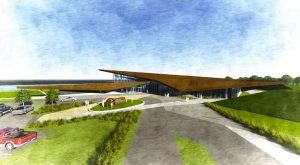Marshals Museum design changes reduce construction cost by more than 50%
by June 13, 2017 5:13 pm 3,071 views

Updated rendering of the planned U.S. Marshals Museum under construction in Fort Smith.
A change in “design and construction modifications” has cut $17 million from the cost to build the U.S. Marshals Museum planned to be built near the Arkansas River in downtown Fort Smith.
The planned 50,000-square-foot national museum is not being reduced in size. Dirt work ahead of museum construction has been reduced in scope after it was determined the ground was more suitable than expected.
“The museum expected to conduct extensive site work this summer to remove and replace unsuitable soil around and up to 16 feet below the proposed structure. However, the current state of the ground is much more solid than initially anticipated. The museum will now move forward with its plans to begin construction in the spring of 2018,” noted a statement issued Tuesday (June 13) by the museum office.
Less dirt work and other changes reduced the estimated construction cost from $33.5 million to $16.5 million – a more than 50% reduction. One of the changes is a smaller “spire feature” that stretches toward the Arkansas River. The initial spire tip was around 102 feet above the ground. The new design has the tip around 50 feet above the ground.
Patrick Weeks, president and CEO of the U.S. Marshals Museum, said Sept. 24, 2019, remains the planned opening date for the museum. The opening date is significant because, Weeks said, it marks the 230th anniversary of the agency created under Congressional approval of the Judiciary Act and signed by President George Washington. The act appointed 13 Marshals, and one of their early duties was to conduct the U.S. Census.
Little Rock-based Polk Stanley Wilcox Architects updated and changed the museum’s design to “reduce the complexity of construction and reduce the overall cost of the project,” noted the statement from the museum office.
“We are excited to unveil these new designs that will allow us to provide visitors with a world-class experience honoring the U.S. Marshals Service,” Weeks noted in the statement. “By implementing a few design changes, we’ll now be able to reap significant cost savings in both construction and future operations.”

Weeks stressed in an interview with Talk Business & Politics the exhibit area and scope has not been reduced in size or cost. Instead, Weeks said, the staff is working to improve and update the “experience” of the exhibits.
MUSEUM FINANCES, HISTORY
According to the museum, the project budget, which includes the cost to build exhibits and operational costs, is $58.661 million. The museum has raised $34.405 million in cash, pledges and in-kind donations, leaving $24.256 million necessary to meet the budget. Weeks said the budget numbers will be updated
In January 2007, the U.S. Marshals Service selected Fort Smith as the site for the estimated 50,000-square-foot national museum. A ceremonial groundbreaking was held in September 2015 on a site near the Arkansas River in downtown Fort Smith, and museum officials initially hoped to have the facility open by late 2017.
The museum is expected to contain three primary exhibition galleries, a temporary exhibits gallery, a Hall of Honor, and a National Learning Center to offer programs for students, adults, and families. The three galleries are: “Marshals Today,” an overview of the role of U.S. Marshals in contemporary society; “A Changing Nation,” telling key stories of U.S. Marshals history; and “Frontier Marshals,” bringing law to the ever-changing frontier.
Weeks said the “experience” of the exhibits is the heart of the museum and the ongoing educational programs managed by Leslie Higgins are the “soul” of the museum. Approximately 13,000 children in 500 schools have participated in some form of museum outreach, Weeks said, adding that the educational outreach will continue to grow even when the museum is open.
